To make natural perfumes, you'll need a steam distillation setup with a borosilicate glass flask, condenser, and collection vessel. Start by sourcing high-quality organic botanicals harvested at peak times for maximum aromatic content. Create your signature scent by blending base notes (30%), middle notes (50%), and top notes (20%) using your distilled essential oils. Store finished perfumes in dark bottles away from heat and light. Master these fundamentals, and you'll reveal endless possibilities for crafting unique fragrances.
Understanding Steam Distillation Equipment
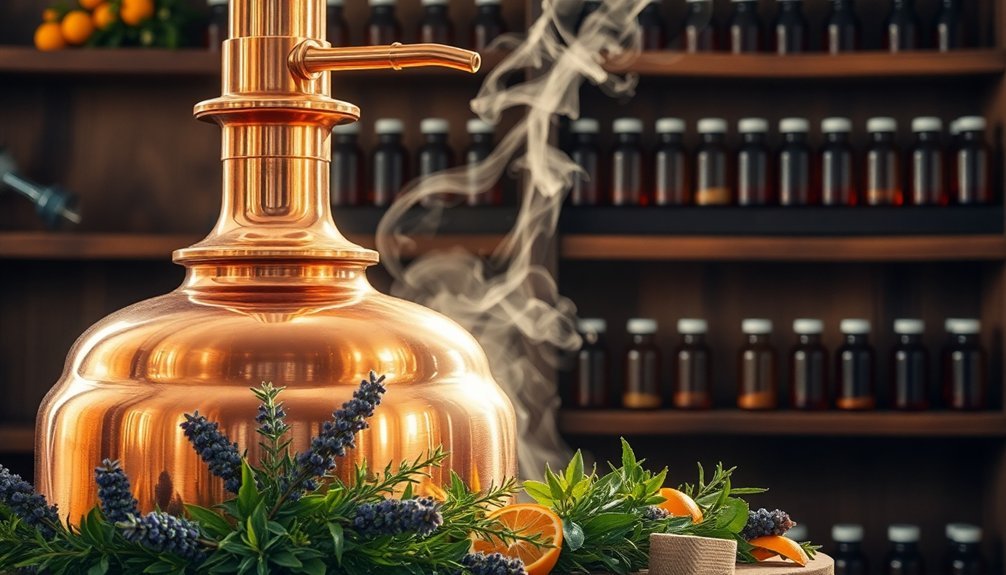
Steam distillation equipment forms the backbone of natural perfume creation, consisting of three main components that work together seamlessly.
You'll need a distillation flask with a round bottom and long neck, typically made from heat-resistant borosilicate glass, to heat and vaporize your botanical materials. The flask connects to a condenser that's tilted downward, cooling the rising vapors back into liquid form.
Your collection vessel sits below the condenser to capture the separated essential oils and floral waters. Steam carries aromatic oils through the system in a gentle, natural extraction process.
You'll control the steam generation either directly in the distilling flask or through a separate steam line. The steam inlet tube guarantees proper bubbling through your botanicals, while a separatory funnel trap helps manage water flow.
For delicate aromas, you can lower the pressure to reduce the boiling point.
Selecting High-Quality Organic Botanicals
You'll find the finest organic botanicals from trusted farms that prioritize sustainable growing practices and careful harvesting methods.
Mountain-grown botanicals, cultivated at higher altitudes, often contain more concentrated essential oils due to their adaptation to harsh environmental conditions.
When selecting your botanical sources, start with reputable mountain farms that can verify their organic certification and demonstrate consistent quality in their harvests. The distilled oils should be evaluated separately as top, middle, and base notes before combining them into your final perfume blend.
Sourcing From Trusted Farms
Three key factors determine the quality of botanicals for natural perfumery: certification standards, harvesting practices, and farm reputation.
When sourcing from trusted farms, you'll want to verify their USDA Organic certification or equivalent international standards, ensuring they follow sustainable and cruelty-free practices. Like traditional naturopath Christa Obuchowski demonstrates, proper certification validates a farm's commitment to quality.
Look for farms that harvest their botanicals at peak times to maximize aromatic content and essential oil yield.
You'll find that seasonal variations affect quality, so partner with farms that understand ideal harvesting windows and proper storage methods.
Before committing to a supplier, research their reputation and connect with their botanical experts, such as perfumers or distillers.
These specialists should demonstrate extensive knowledge in plant medicine and sustainable practices.
Consider attending their workshops or reviewing their publications to assess their expertise before establishing a long-term sourcing relationship.
Mountain Grown Botanicals First
Building on trusted farm relationships, selecting high-quality organic botanicals starts with understanding their growth environment. Mountain-grown varieties often yield superior aromas due to their pristine growing conditions and natural adaptations to higher altitudes.
You'll want to prioritize organically certified botanicals to guarantee they're free from pesticides and chemicals that can concentrate during distillation.
When selecting materials for steam distillation, focus on delicate botanicals like balsam poplar buds and fir balsam, which respond well to this gentle extraction method. For best results, use fresh botanicals whenever possible, as they provide richer, more vibrant aromas than their dried counterparts.
If you're working with dried materials, verify their proper storage and handling to maintain aromatic quality. Always request quality testing documentation and organic certificates to confirm your botanicals' purity and authenticity.
Essential Safety Measures for Home Distillation
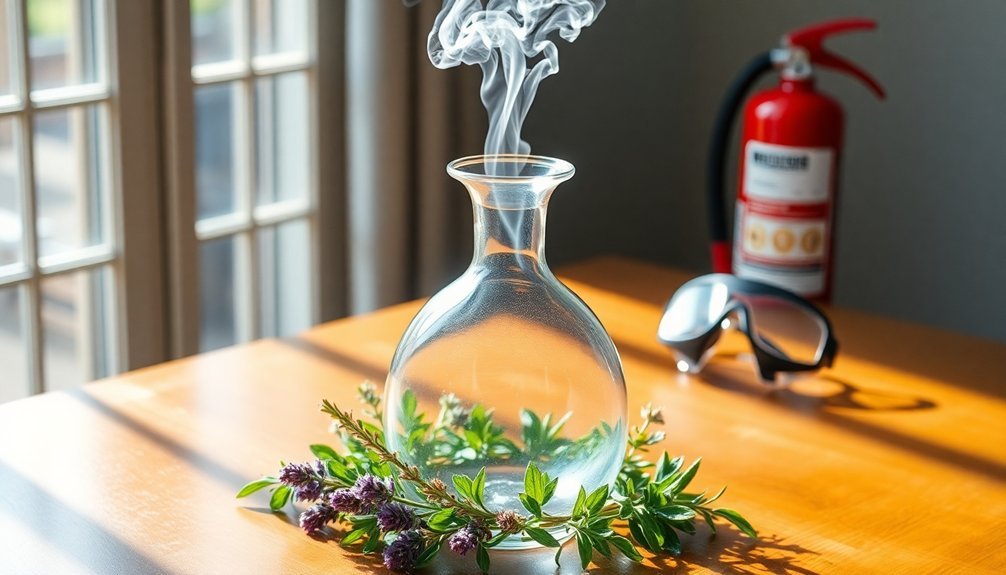
Safety stands at the forefront of any home distillation project, requiring careful attention to protective measures and protocols.
You'll need to wear heat-resistant gloves, safety goggles, and an apron to protect against burns, steam, and spills while working with your botanical distillation setup.
Keep your workspace well-ventilated and free from ignition sources. You'll want to install exhaust fans or open windows to prevent vapor buildup.
Make sure you've got a Class B fire extinguisher nearby, and avoid using open flames in your distillation area.
Monitor temperatures carefully using reliable gauges, and don't let your still overheat.
Regularly inspect your equipment for leaks or damage, and maintain all components in top condition.
Setting Up Your Steam Distillation Station
Before diving into the distillation process, you'll need to assemble a proper workstation with essential equipment and materials. Gather a heat-resistant pot with lid, glass bowl for botanicals, boiling flask, condenser, and separatory funnel.
Set up your station by positioning the botanicals in a separate chamber above the water level. Connect your boiling flask to generate steam, ensuring it passes through the plant material without direct water contact. Attach the condenser to cool and liquefy the vapor effectively.
Keep a close eye on temperature using a thermometer, and maintain ideal steam pressure throughout the process.
You'll want to prepare your botanicals beforehand by cleaning and trimming them to maximize surface exposure. Use fresh or dried organic materials, and store them properly until you're ready to begin distillation.
The Step-by-Step Distillation Process
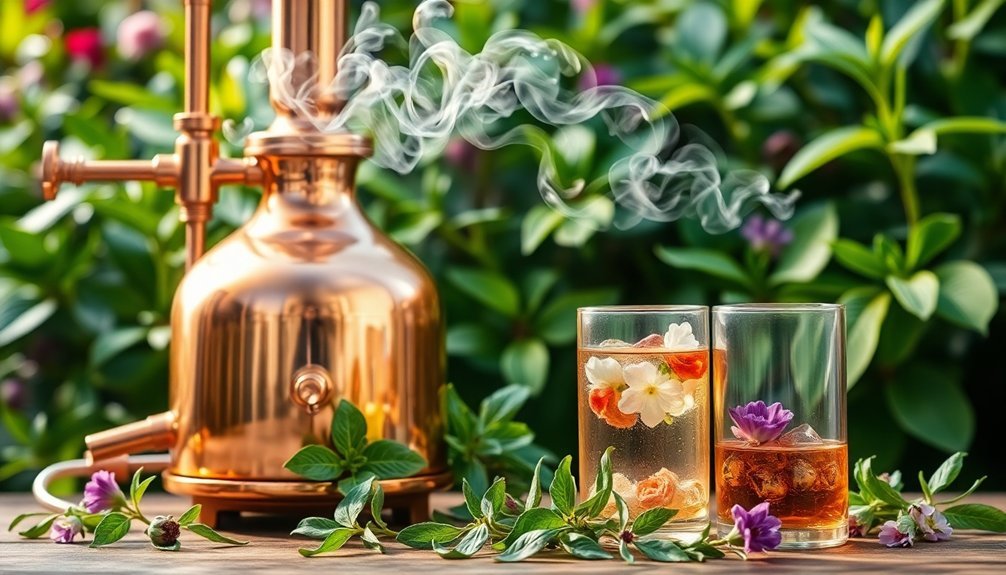
You'll need to arrange your distillation equipment in a specific sequence: boiling flask, plant material chamber, condenser, and collection vessel.
Your steam generator should maintain steady pressure and temperature control to effectively extract essential oils from your chosen botanicals.
Once you've connected all components securely, check for any leaks before starting the heating process.
Setting Up Equipment Properly
Proper equipment setup forms the foundation of successful steam distillation for natural perfumes. You'll need to carefully assemble each component of your distillation apparatus, ensuring they're securely connected.
Position your still first, then attach the condenser, making sure it's properly aligned for ideal steam flow. Don't forget to prepare your collection vessel to catch the valuable distillate.
- Use high-quality, durable materials that won't react with your essential oils
- Double-check all connections to prevent steam leaks
- Keep safety equipment within reach, including heat-resistant gloves
- Position your separator nearby for efficient oil collection
Remember to handle all components with care and verify that your setup is stable before beginning the distillation process. A well-assembled apparatus will greatly improve your perfume-making results.
Optimal Extraction Through Steam
When mastering steam distillation, understanding the sequential steps guarantees ideal extraction of aromatic compounds from your botanicals. You'll need to place your plant material in a separate chamber, allowing steam from the boiler to diffuse through it efficiently. As the steam rises, it'll carry volatile compounds to the condenser where they'll liquefy.
| Process Stage | Key Action |
|---|---|
| Initial Phase | Load botanicals into chamber above boiler |
| Middle Phase | Steam carries volatiles through condenser |
| Final Phase | Collect separated oil and hydrosol |
Watch for the distillate to separate into distinct layers – essential oil floating on top of the water. You'll notice the head of your run appears cloudy with high oil concentration, while the tail runs clearer. Some botanicals may require multiple distillations for peak extraction, particularly when creating different grades of essential oil.
Harvesting and Processing Your Essential Oils
The art of essential oil production begins with careful plant selection and meticulous processing techniques. You'll want to harvest your plants during peak fragrance hours when their aromatic compounds are strongest. Before extraction, thoroughly clean your plant materials to remove any debris that could affect oil quality.
- Store your freshly harvested plants in cool, dark conditions to preserve their natural compounds.
- Check oil purity using GC/MS analysis if you have access to professional testing.
- Keep your extracted oils in dark glass containers away from heat and light.
- Document each batch with details like botanical name, harvest date, and extraction method.
Once you've extracted your oils, handle them with care. Remember that they're highly concentrated substances that require proper safety precautions.
When storing your finished oils, cool temperatures and airtight containers will help maintain their potency and extend shelf life.
Basic Perfume Blending Techniques
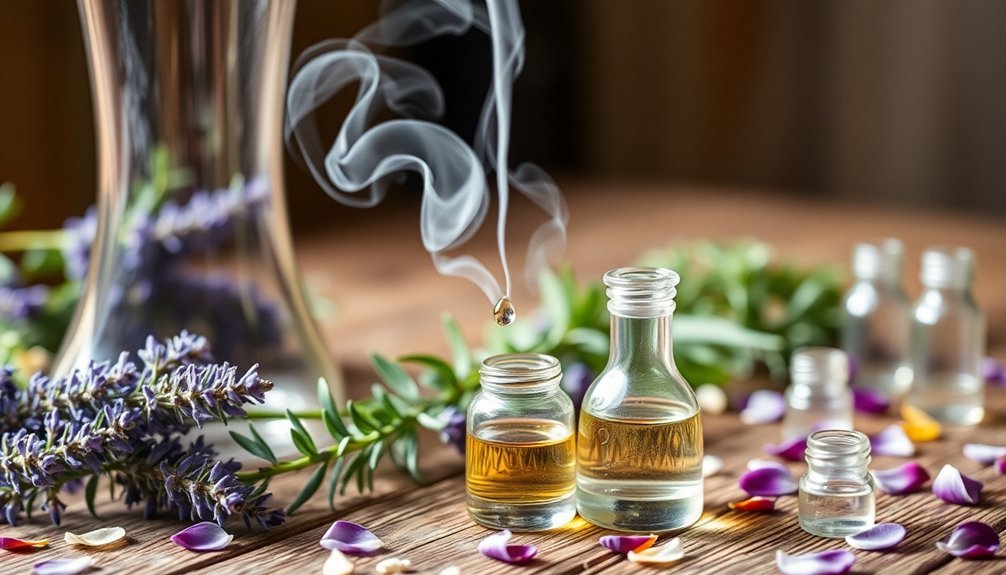
You'll want to create your natural perfume by first establishing a solid foundation with base notes like vanilla or cedarwood.
Next, build the heart of your fragrance by layering in middle notes such as rose or lavender to add complexity and depth.
Finally, complete your blend by incorporating top notes like bergamot or wild orange, allowing the entire composition to mature for at least a week before making final adjustments.
Creating Base-Middle-Top Balance
Creating a balanced natural perfume requires understanding three distinct layers: base, middle, and top notes.
You'll want to start with your base notes, which provide depth and longevity, making up about 30% of your blend.
Next, add middle notes to bridge the gap between base and top notes, comprising roughly 50% of your composition.
Finally, incorporate top notes for that initial burst of fragrance, accounting for approximately 20% of the blend.
- Begin by testing up to three base oils like sandalwood or myrrh on scent strips
- Add middle notes such as lavender or rose to create harmony between layers
- Introduce top notes like bergamot or lemon one drop at a time
- Keep detailed notes of your blending process to track successful combinations
Layering Essential Oil Notes
Layering essential oils requires a methodical approach that builds from deep, lasting base notes to fleeting top notes. Begin by adding 5-10% base notes like Sandalwood or Patchouli to establish your foundation. Next, blend in your middle notes, which will make up 50-75% of your perfume – try florals like Rose or Geranium. Finally, add your top notes sparingly to create that initial bright impression.
| Note Layer | Percentage | Examples |
|---|---|---|
| Top Notes | 15-25% | Lemon, Bergamot, Mint |
| Middle Notes | 50-75% | Lavender, Rose, Geranium |
| Base Notes | 5-10% | Sandalwood, Vanilla, Cedarwood |
Let your blend mature for several weeks, testing periodically on your skin. Keep detailed records of your ratios to replicate successful blends. This drop-by-drop technique allows you to fine-tune your fragrance until you achieve the perfect balance.
Creating Signature Scent Combinations
Three essential elements form the foundation of any signature scent: creativity, patience, and understanding of fragrance notes.
When creating your personal blend, start with 2-3 essential oils that resonate with your desired fragrance profile. Test small combinations on your skin to observe how the scent develops over time, and don't hesitate to adjust the ratios until you achieve the perfect balance.
- Begin with simple combinations of complementary oils, like citrus with earthy notes or floral with woody undertones.
- Test your blend by applying a small amount to your skin and tracking its evolution throughout the day.
- Adjust the number of drops for each oil carefully – even minor changes can dramatically alter the final scent.
- Consider developing seasonal variations of your signature scent for different occasions and times of year.
Storing and Preserving Your Natural Perfumes
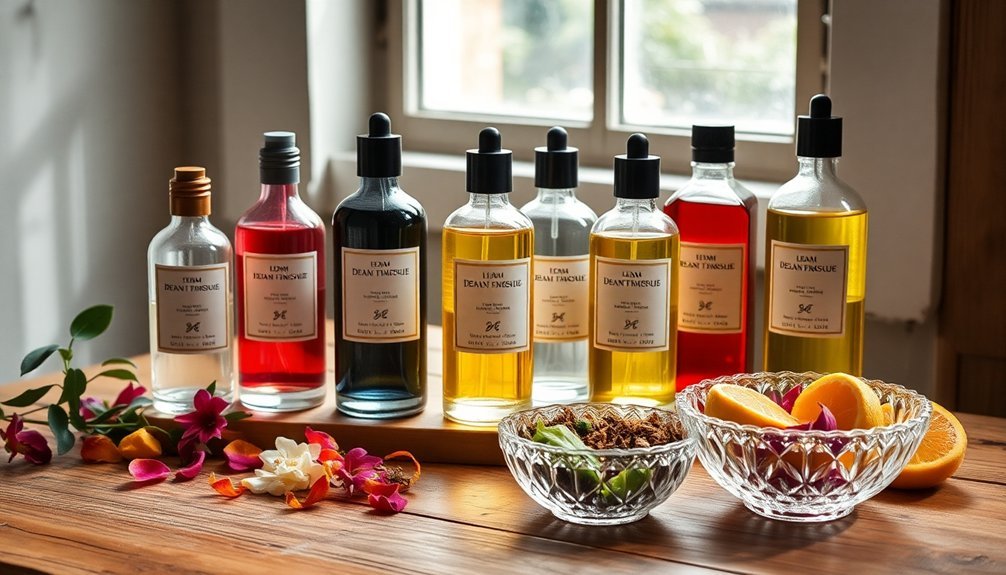
After perfecting your signature scent blend, proper storage becomes the key to maintaining its quality and character.
Store your natural perfumes in cool, dark places like closets or dresser drawers, away from sunlight and heat sources. You'll want to avoid windowsills and steamy bathrooms that can degrade your fragrances.
To maximize longevity, guarantee your bottles have airtight seals and consider adding natural preservatives like grapefruit seed extract or Vitamin E oil.
If you're working with larger quantities, refrigeration can help slow down chemical reactions and extend shelf life.
Don't forget to use dark, protective containers that shield your blends from UV damage.
Remember to let your perfumes mature for a week before adding antioxidants, and regularly check for any changes in scent or signs of deterioration.
Troubleshooting Common Distillation Issues
When beginning your steam distillation process, you'll likely encounter several common challenges that can affect your final product's quality. Regular equipment inspections and maintenance will help prevent most issues, while proper monitoring of the distillation process guarantees ideal results.
Check your glassware for damage, keep seals properly greased, and perform leak tests to maintain system integrity.
- Watch for blockages in your column and clean regularly with appropriate solvents
- Monitor the water-oil separation process, using Dean Stark traps if needed
- Avoid overheating your botanicals to preserve delicate aromatic compounds
- Use only organic plant materials to prevent pesticide concentration in your final product
If you notice inconsistent results, adjust your process parameters and remember that different botanicals may require unique distillation conditions.
Seasonal Variations in Botanical Extraction
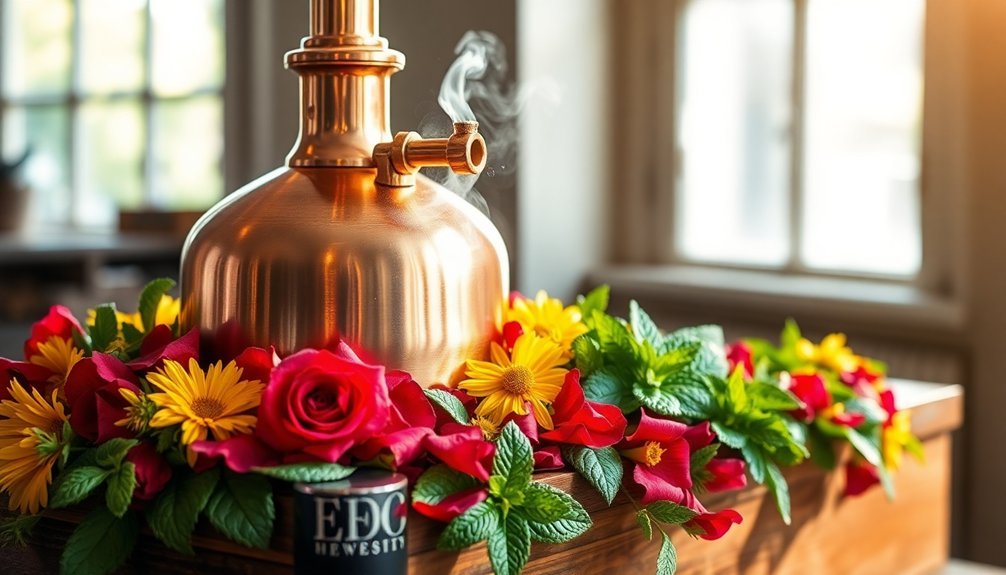
The art of natural perfumery shifts dramatically with each passing season, as nature's aromatic offerings change throughout the year.
In spring, you'll find intense floral notes from roses, jasmine, and orange blossoms, which must be harvested at dawn for prime essence extraction.
Summer brings resinous saps from frankincense and myrrh, while citrus peels offer bright, invigorating notes through cold-pressing.
As autumn arrives, you can harvest vetiver roots and coriander seeds, which provide earthy and spicy elements to your perfumes.
Winter's bounty includes warm, comforting scents from sandalwood and cedarwood heartwood, along with crisp notes from evergreen needles.
You'll need to adjust your extraction methods and timing based on these seasonal variations to capture each botanical's unique essence at its peak potency.
Scaling Up Your Perfume Production
Successfully scaling up perfume production requires careful attention to both technical precision and cost management.
You'll need to convert your drop-based formulas into weight-based measurements while guaranteeing each ingredient maintains its proper proportion. When working with expensive materials like jasmine oil, which can cost up to $100,000 per kilogram, strategic sourcing becomes essential to maintain profitability.
Key considerations for scaling up your production:
- Convert your formulas to percentages and weights rather than drops for consistent large-batch manufacturing
- Invest in automated filling equipment and bulk mixing vessels to improve efficiency and reduce labor costs
- Implement rigorous quality control testing to guarantee each batch matches your master formula
- Balance the use of natural extracts with synthetic alternatives to optimize costs while maintaining product integrity
Frequently Asked Questions
How Long Does the Natural Perfume Scent Typically Last on Skin?
You'll notice natural perfumes typically last 2-4 hours on your skin, similar to eau de cologne. However, if you've got oily skin or apply to moisturized areas, you'll get slightly longer wear time.
Can I Use Dried Herbs Instead of Fresh Ones for Distillation?
Yes, you can use dried herbs for distillation. They're often more efficient due to lower water content and give concentrated yields. However, some herbs like rose and bay leaf work better when distilled fresh.
What Causes Cloudiness in My Distilled Essential Oils?
Your distilled oils may become cloudy due to insoluble particles, temperature changes, or interactions between oils and water. When you're working with polar and nonpolar components, they'll naturally separate or create cloudiness.
Why Do Some Botanicals Yield More Essential Oil Than Others?
You'll find that botanical yields vary due to their unique cellular structures, oil storage capacity, and plant genetics. Environmental conditions and plant parts also influence how much essential oil they'll naturally produce.
Can I Blend Essential Oils From Different Distillation Methods Together?
Yes, you can blend essential oils from different distillation methods together, but you'll need to account for varying aroma strengths. Steam-distilled oils often have stronger, more natural scents than those from simple distillation.
In Summary
You're now equipped to create your own natural perfumes through steam distillation. By following proper safety protocols, selecting quality botanicals, and mastering the distillation process, you'll craft unique fragrances right from your home. Remember to store your creations properly and adjust your techniques with the seasons. Whether you're making perfumes for personal use or planning to scale up, you've got the foundation for success.

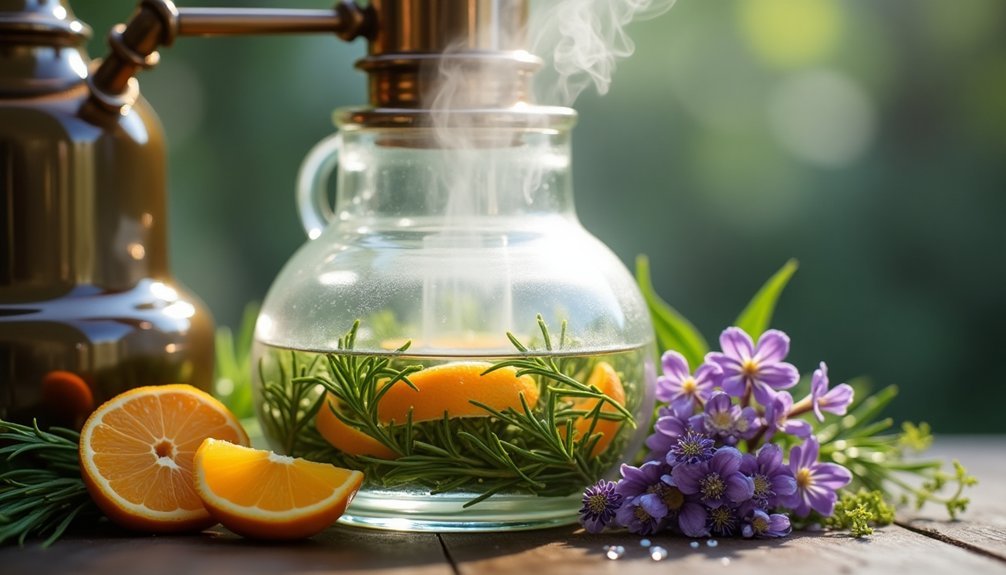
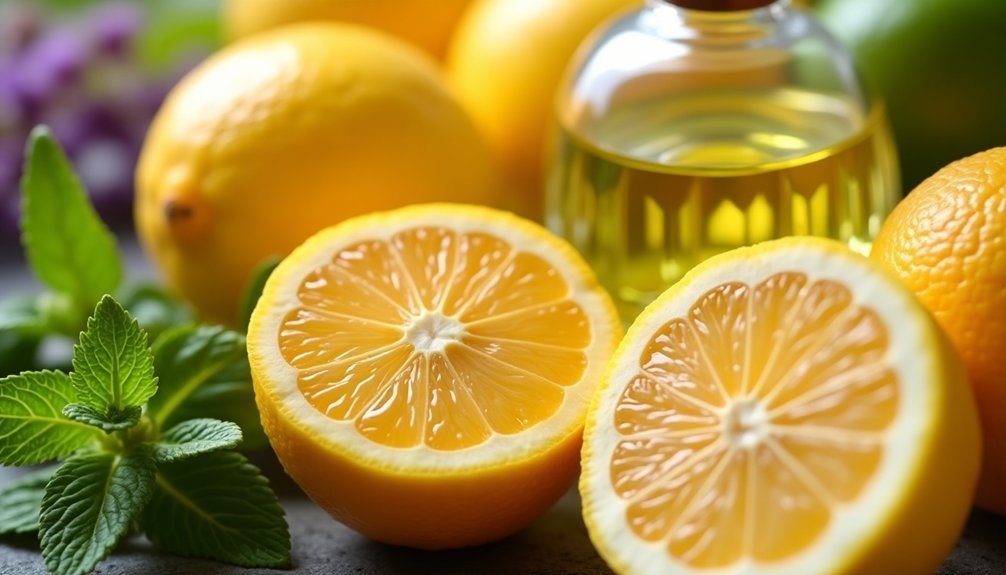
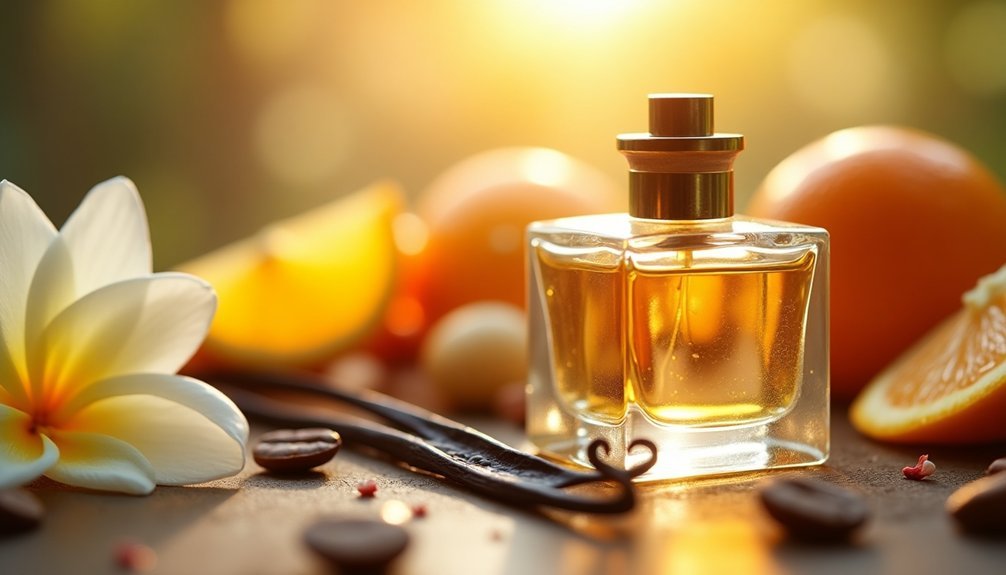

Leave a Reply